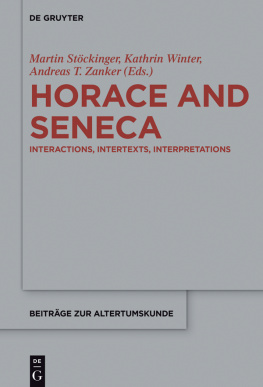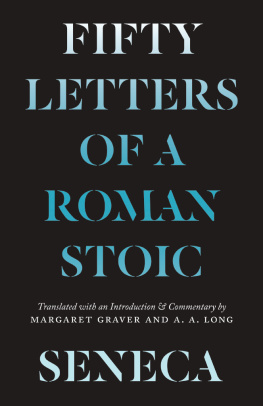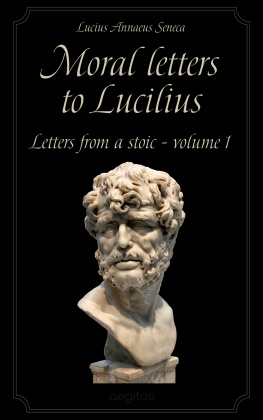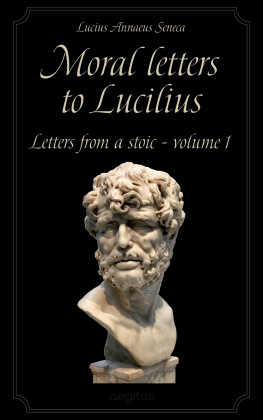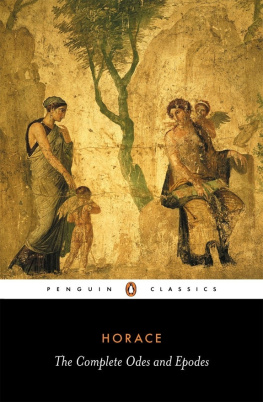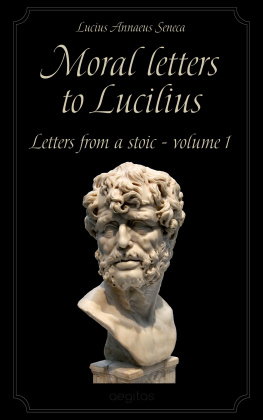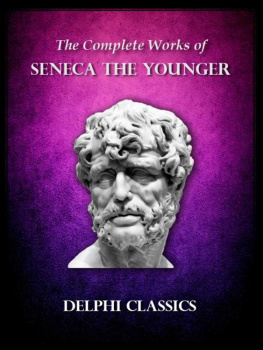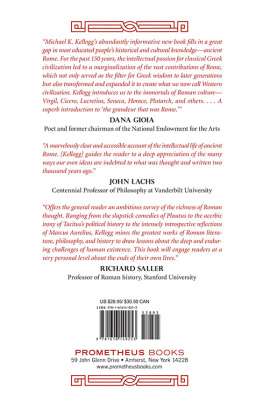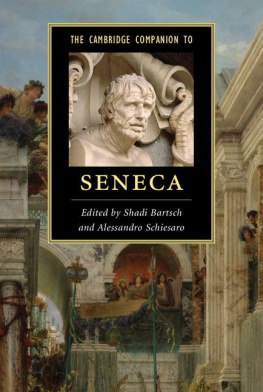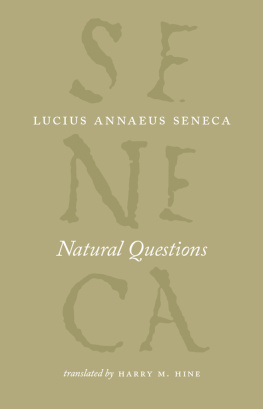Table of Contents
Guide

Horace and Seneca
Beitrge zur Altertumskunde

Herausgegeben von Susanne Daub, Michael Erler, Dorothee Gall, Ludwig Koenen und Clemens Zintzen
Band 365

ISBN 978-3-11-052402-4
e-ISBN (PDF) 978-3-11-052889-3
e-ISBN (EPUB) 978-3-11-052861-9
ISSN 1616-0452
Library of Congress Cataloging-in-Publication Data
A CIP catalog record for this book has been applied for at the Library of Congress.
Bibliografische Information der Deutschen Nationalbibliothek
Die Deutsche Nationalbibliothek verzeichnet diese Publikation in der Deutschen Nationalbibliografie; detaillierte bibliografische Daten sind im Internet ber http://dnb.dnb.de abrufbar.
2017 Walter de Gruyter GmbH, Berlin/Boston
www.degruyter.com
Foreword
This volume is based on a conference held in the Seminar fr Klassische Philologie at the University of Heidelberg in July of 2015. In its production we would like to register our sincerest thanks to the Alexander von Humboldt Stiftung and Amherst College, as well as to the Mommsen Gesellschaft, for their generous funding. We would also like to thank Jrgen Paul Schwindt and Gerrit Kloss for their support of the project, as well as the administrators and student helpers who made the conference itself run so smoothly. The typescript was edited with aplomb by Eugenia Lao.
We would like to dedicate the volume in the name of all of its contributors to the memory of our keynote speaker, John Moles, who, with his customary generosity and enthusiasm, contributed greatly to the original gathering. Only two months after we met in Heidelberg we were deeply saddened to hear that he had passed away. The three editors of the present volume still remember, and always will, our walk with John across Heidelbergs Alte Brcke over the Neckar on the late-summer afternoon before the conference began.
Notes concerning the texts and translations employed are provided in the individual contributions. Abbreviations of names and titles follow the conventions of the LSJ and OLD. Latin titles, when cited in full, are generally printed in the original, save for Horaces Odes , Epodes , Satires , and Epistles , whose frequency in the scholarship, we feel, overrides our aspirations to uniformity (this also allows Senecas Epistulae Morales to be more clearly differentiated from Horaces Epistles ).
Martin Stckinger, Kathrin Winter, Andreas T. Zanker
Introduction
The pairing of two authors may appear both old-fashioned and arbitrary in twenty-first century classical studies: the comparison of Homer and Virgil, Pindar and Horace, Sallust and Tacitus, and Virgil and Lucan has provided topics for numerous books, articles, and chapters over the decades. The abundance of such studies has in part been balanced by the changing scholarly modes of dealing with the literary relationships involved terms such as imitatio and aemulatio , influence, anxiety of influence, allusion, reference, intertextuality, tradition, dynamics of genre, and reception, to give but a few examples, each come with their own emphases and framings of the connections between texts and authors. But why add another pairing to this vast body of scholarship? And why the particular pairing of Horace and Seneca? A preliminary, and somewhat blunt, answer is that to the best of our knowledge no one has undertaken it before, at least not with due consideration to the entire oeuvres of both authors.
Several studies from the nineteenth and early twentieth century address or touch on Horace and Seneca in tandem, often as part of an investigation of an author-specific topic such as Senecas technique of imitation or tropes in Senecan tragedy: by way of example we might note Zingerle (1873), Gaheis (1895), Kapnukajas (1930), and Keseling (1941). Two scholars of this period focused exclusively on the relationship between Senecas tragedies and Horaces Odes Gerber (1883), who explored Senecas use of Horatian metre, and Spika (1890), who listed verbal parallels and imagery common to both Horaces Odes and the choral odes of Seneca. Although these studies still offer much useful material, their methodology is of course dated. In more recent decades, we find two brief overviews by Mazzoli (1974 and 1998) and an influential essay by Berthet (1979), in addition to a number of articles devoted to specific problems and topics by other scholars. however, is a comprehensive study of the relationship of the Horatian corpus to Senecas philosophical and poetic works, one that takes into account modern critical theory and methodologies. First steps in this direction have recently been taken by Trinacty (2014), with a focus on Horaces Roman Odes, and by Rimell (2015a, 82147), whose study of the concept of enclosed space includes an analysis of the Horatian angulus and its reception in Senecas prose.
But beyond this need to fill a gap in the scholarship, the study of the interplay between these two authors is attractive for a variety of other reasons. Horace and Seneca reveal, for example, in many respects striking similarities, but are at the same time paradoxically dissimilar precisely at these points of contact. Both authors write philosophy in a literary framework and thereby engage continually with the same themes and questions for example the idea of the good life, the proper use of time, the formation of the self, the desideratum of moderation yet do so from different philosophical angles (namely quasi-Epicureanism and Roman Stoicism). Both have been criticised for their proximity to political power, yet this proximity takes a different form in each case Horace slowly approaching the centre of power from great distance, Seneca swiftly distancing himself from his position of great intimacy with Neros court. Both work in a variety of different genres in the course of their long careers, which, although the precise genres diverge greatly, constitute analogous forms: philosophical letters (whether in poetic sermo or in prose), dialogue (as can already be noted in the authors use of the terms sermo and dialogus as descriptors for individual works), the influence of diatribe and satire (housed in completely different genres), and of course lyric and here Senecas choral songs would be unthinkable without Horaces Odes , even if they exist in a different context and serve a different end. Finally, we might mention the similarities when it comes to the authors ironic style, together with the formal correspondences even down to the minora which make the case for a deep underlying connection between the two authors all the more compelling. None of these items is precisely replicated, and yet the similarity is too clear to be denied.
Even from a superficial syncrisis such as that just outlined one recognises the fundamental and perhaps unique character of the relationship between Horace and Seneca: it consists in similarity rather than uniformity. The corpora are of course extremely different, yet when set next to each other they reveal themselves to be interlaced with non-systematic parallels and congruencies in their composition, their workmanship, and in numerous details (although never in their entirety). The relationship has the appearance of being both intimate and distanced. It is precisely in this that the fascination of the theme Horace and Seneca lies, as well as its great difficulty: sweeping attempts to describe the relationship exhaustively or to provide an underlying axiom for its analysis generally lack persuasive force, and mapping out the connections demands of the critic both subtlety and a willingness to deal more frequently with twilight potentialities than with clear moments of open interaction. We believe that the very obstacles to the study of Horace and Seneca in tandem in fact present an opportunity: they not only open up the possibility of examining an interesting relationship between two eminent authors of the Roman literary canon, but also force us to touch on a number of fundamental issues of literary criticism, and as such to reassess the tools and terminology that we are accustomed to apply in such investigations. In what follows we shall give a few examples to show precisely why we think it is worth exploring this particular relationship and note some of the aforementioned obstacles, before describing the rationale and contents of the volume itself.

